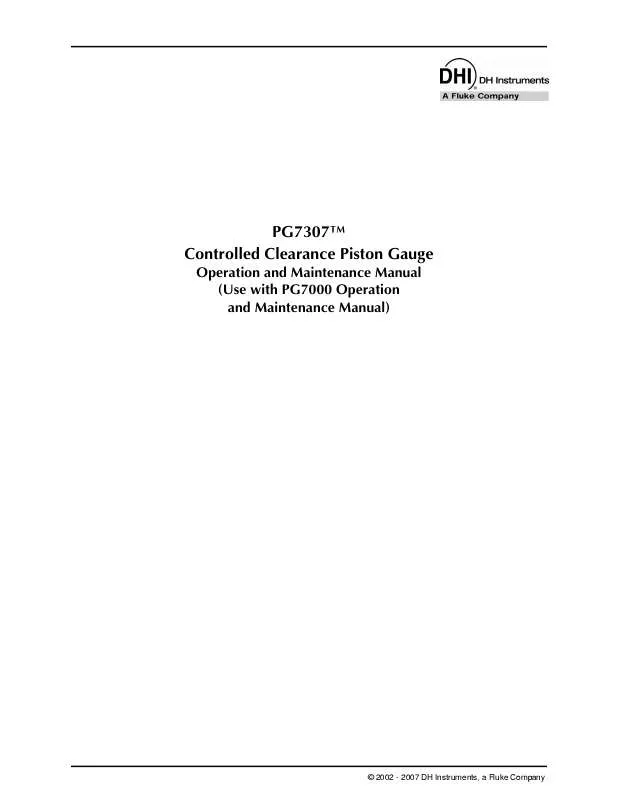User manual FLUKE PG7307
Lastmanuals offers a socially driven service of sharing, storing and searching manuals related to use of hardware and software : user guide, owner's manual, quick start guide, technical datasheets... DON'T FORGET : ALWAYS READ THE USER GUIDE BEFORE BUYING !!!
If this document matches the user guide, instructions manual or user manual, feature sets, schematics you are looking for, download it now. Lastmanuals provides you a fast and easy access to the user manual FLUKE PG7307. We hope that this FLUKE PG7307 user guide will be useful to you.
Lastmanuals help download the user guide FLUKE PG7307.
Manual abstract: user guide FLUKE PG7307
Detailed instructions for use are in the User's Guide.
[. . . ] PG7307TM Controlled Clearance Piston Gauge
Operation and Maintenance Manual (Use with PG7000 Operation and Maintenance Manual)
© 2002 - 2007 DH Instruments, a Fluke Company
High pressure liquids and gases are potentially hazardous. Energy stored in these liquids and gases can be released unexpectedly and with extreme force. High pressure systems should be assembled and operated only by personnel who have been instructed in proper safety practices.
© 2002 - 2007 DH Instruments, a Fluke Company All rights reserved. Information in this document is subject to change without notice. [. . . ] The O-ring assembly (18) is NOT intended to be regularly disassembled. Do not proceed with the next step of disassembly unless it is suspected that a repair is required. Do not proceed with the next step of disassembly if you do NOT have a new set of O-rings (10, 12, 14, 15, 17) and anti-extrusion ring (16) to use in reassembly. It is imperative that new parts be used in reassembly (not all modules have an antiextrusion and all the O-rings (see Table 2)).
Using a 2 mm Allen tool, loosen the two O-ring assembly retaining screws (21). Lift off the O-ring assembly (18) and the retaining screws. Remove O-rings (14, 17) and the anti-extrusion ring (16) (PC-7307-200 and -100 do NOT have an anti-extrusion ring).
In reassembly, after the two sleeve retaining screws (5) are installed, sleeve assembly (9+13+18) must still have a small amount of freedom to move and rotate within the main module housing (4).
While firmly holding down the cap (2), use a 5 mm Allen tool, to loosen the socket head cap retaining screw (1). Turning the screw pushes the piston head (6) straight out of the piston cap (2) ensuring that no sideways torque is applied to the piston (7). The cap retaining screw will not fully disengage from the piston cap due to the adjustment mass (3). Gently remove the cap and screw from the assembly. Use caution to be sure the piston head is out of the cap
In reassembly use new O-rings and anti-extrusion ring only and take special care to center the anti-extrusion ring on the shoulder of part (18).
Holding the cylinder (11) in the open end of the cylinder sleeve (13), turn the cylinder sleeve over and allow the cylinder to gently slide out. Using a 3 mm Allen tool, loosen the cover retaining screws (8). Remove the cover (9) and remove the O-ring (12).
In reassembly use new O-rings. The end of the cylinder marked with the serial number must be upwards (towards the cover (9)).
The orientation of the piston on the cylinder is important. The end of the cylinder that is marked with the serial number should be upwards (against the sleeve cover (9)). Installing the cylinder with the wrong orientation may lead to out of tolerance measurements.
© 2002 - 2007 DH Instruments, a Fluke Company
Page 14
5. TROUBLESHOOTING
5.
5. 1
TROUBLESHOOTING
OVERVIEW
Identify the symptom or unexpected behavior you are observing from the SYMPTOM list below. A PROBABLE CAUSE is provided and a SOLUTION is proposed including references to manual sections that provide information that may be of assistance. Table 3 concerns troubleshooting issues for the PG7307 only. See the PG7000 Operation and Maintenance Manual for the complete PG7000 troubleshooting checklist.
Table 3. PG7307 Troubleshooting Checklist
SYMPTOM Piston lacks sensitivity/mobility. Piston rotation rate decreases too rapidly. PROBABLE CAUSE Controlled clearance pressure too high relative to measured pressure is causing gap between piston and cylinder to be too small. [. . . ] The normal piston-cylinder gap size is from 0. 6 to 1. 2 micrometers. The specific size is determined by piston-cylinder diameter to optimize performance when operated with a controlled clearance pressure value that causes the deformation coefficient to be close to zero. However, the gap size can be adapted for other considerations, for example to allow the ccp to be as high as 100 % of the measured pressure. The controlled clearance piston-cylinder module parts are designed to operate with controlled clearance pressure up to 100% of the measured pressure to a maximum of 100 MPa, assuming the piston-cylinder gap is sized to allow it. [. . . ]
DISCLAIMER TO DOWNLOAD THE USER GUIDE FLUKE PG7307 Lastmanuals offers a socially driven service of sharing, storing and searching manuals related to use of hardware and software : user guide, owner's manual, quick start guide, technical datasheets...manual FLUKE PG7307


